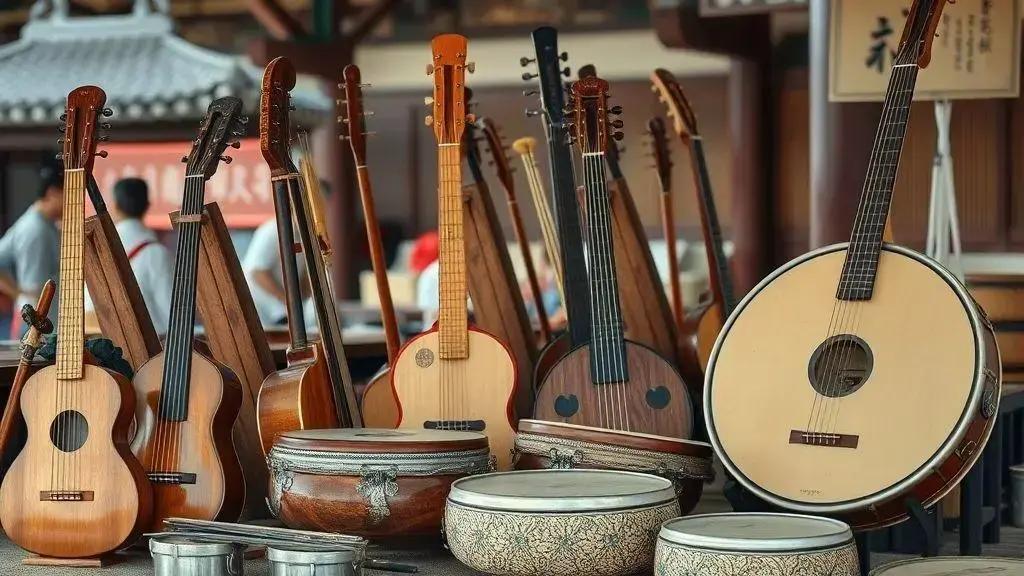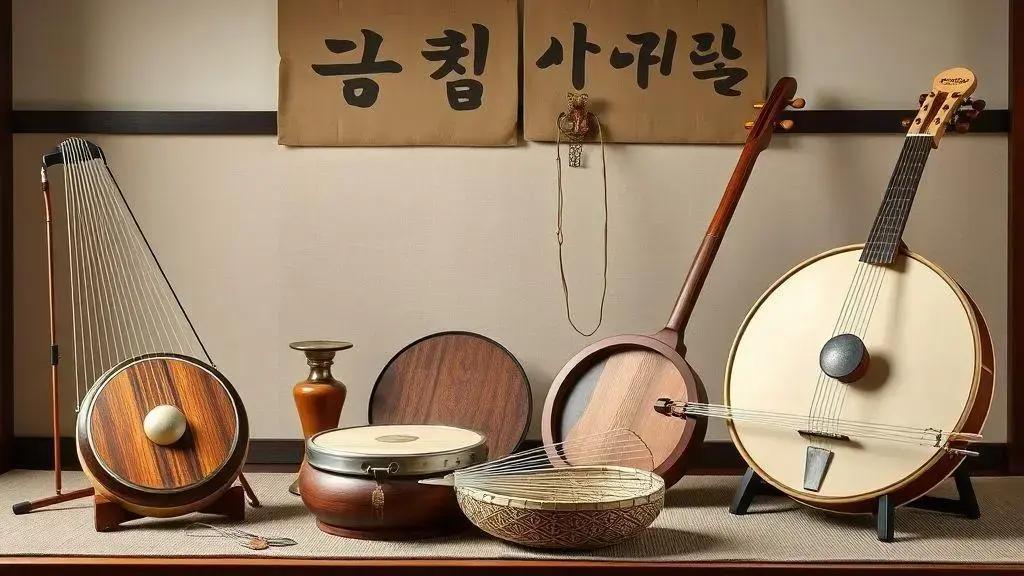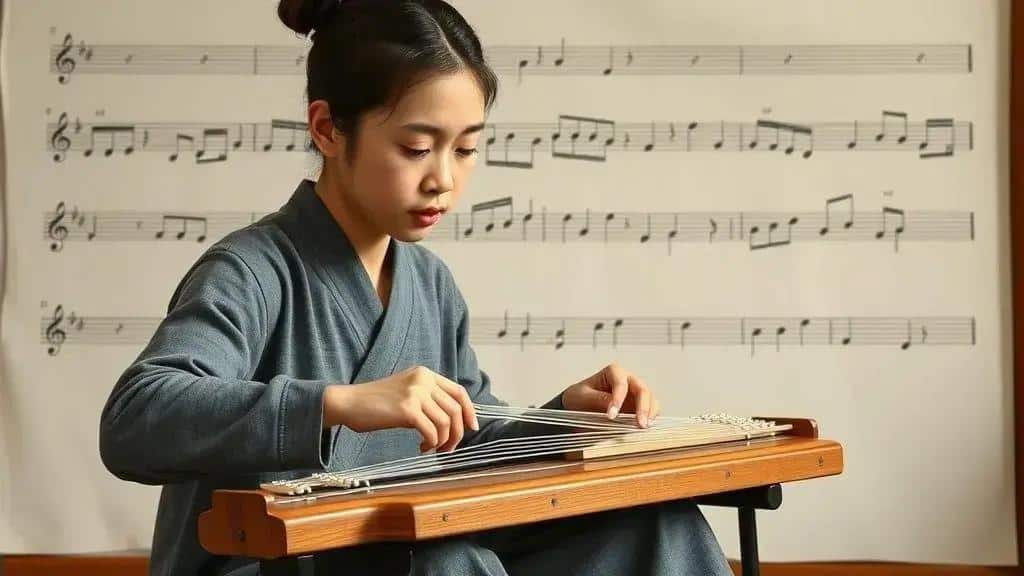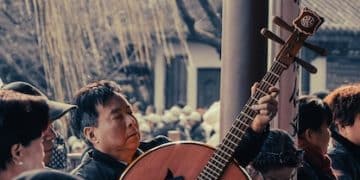Korean traditional music instruments: explore their unique sounds

Korean traditional music instruments, including the gayageum, geomungo, piri, and haegeum, play a vital role in cultural expression, enhancing performances and connecting musicians to their heritage through their unique sounds.
Korean traditional music instruments hold a unique charm that resonates through rich cultural heritage. Have you ever wondered how these instruments shape the sound of Korean music? Let’s take a closer look.
Introduction to Korean traditional music instruments
The introduction to Korean traditional music instruments reveals a world rich in history and sound. These instruments not only create beautiful music but also serve as cultural symbols.
Diverse Range of Instruments
Korean traditional music includes a variety of instruments, each with its unique sound. Some of the most notable are:
- Gayageum: A string instrument, often compared to the zither, known for its soothing melodies.
- Geomungo: A six-string zither that produces a deep, resonant sound, often used in court music.
- Piri: A bamboo oboe that adds a vibrant, piercing tone to ensembles.
- Haegeum: A two-string fiddle played with a bow, known for its expressive sound.
Each instrument plays a vital role in Korean music, reflecting the country’s cultural essence. As you explore these instruments, you will find that they are often used in various types of performances, from folk music to classical pieces.
Performances and Cultural Significance
The performance of Korean traditional music is often enriched by the instruments’ interplay. Musicians skillfully combine the sounds to enhance storytelling and cultural expressions. For instance, during traditional festivals, you might hear the lively sounds of the samulnori, a percussion quartet that showcases the rhythm and energy of Korean heritage.
This harmonious blend of instruments not only creates mesmerizing music but also fosters a connection among performers and audiences alike. Whether in intimate gatherings or grand cultural festivals, the impact of these instruments is profound.
In Korean culture, each instrument is more than just a tool for making music; it represents artistic expression, tradition, and a deep connection to the past. From the gentle strings of the gayageum to the bold notes of the piri, every sound tells a story.
Popular instruments in Korean music

When exploring popular instruments in Korean music, you’ll discover a variety of tools that shape the melodies and rhythms unique to this culture. Each instrument brings a distinct voice to the music, creating a vibrant soundscape.
Key Traditional Instruments
Among the most beloved instruments are:
- Gayageum: A stringed instrument, similar to a zither, known for its soft, gentle tones that evoke deep emotions.
- Geomungo: Another string instrument, but this one features a darker, more resonant sound, perfect for traditional court music.
- Haegeum: This two-string fiddle offers a unique sound, often described as haunting, making it a favorite in ensemble performances.
- Piri: A bamboo oboe that adds a sharper, more demanding sound, it’s often used in traditional folk songs.
These instruments not only provide music but also tell stories about Korea’s history and traditions. The gayageum is particularly famous for its role in solo performances, where it showcases the musician’s skill. Meanwhile, the geomungo often accompanies traditional dance, enhancing the visual art with its deep tones.
The Role of Percussion
No discussion of Korean music is complete without mentioning percussion instruments. The janggu, or hourglass drum, is central to many performances. Its infectious rhythms can stir excitement in any audience. This drum is vital in various traditional music genres and celebrations.
As people delve into Korean music, they find that these instruments work together to create a rich auditory experience. The haegeum and other instruments blend seamlessly, captivating listeners. The unique sounds help bring forth the essence of Korean culture, reflecting its past while continuing to evolve.
The significance of traditional instruments in performances
The significance of traditional instruments in performances goes beyond just creating sound; they serve as a bridge between history and culture. These instruments help tell stories, express emotions, and connect performers with their audience.
Expressing Cultural Identity
Each traditional instrument carries its own story and significance. For example, the gayageum is often used in solo performances to convey deep personal feelings, while the geomungo adds a richness to ensemble pieces that resonate with the audience.
- Connection to Heritage: Musicians often feel a strong connection to their culture through these instruments. Playing them can evoke memories and give insight into Korean traditions.
- Enhancing Performances: During performances, these instruments enhance the emotional impact of the music. Their unique sounds complement the narratives, making stories even more engaging.
- Educational Value: Traditional instruments teach younger generations about their cultural heritage. Learning to play them fosters appreciation for historical music.
As the rhythms of instruments like the piri pierce through the air, they invite listeners to engage with the music deeply. This interaction creates a communal experience, where audiences feel both the joy and the sorrow embedded in the sounds.
Symbol of Unity
The use of traditional instruments also symbolizes unity among musicians. When they perform together, each instrument contributes to a larger sonic tapestry. This collaboration showcases the importance of teamwork in musical expressions.
During festivals and cultural events, you’ll often see these instruments at the forefront, drawing crowds together in celebration. The haegeum and others work together, creating a sound that is at once familiar yet fresh, resonating deeply with roots while also embracing modern interpretations.
How to play and appreciate Korean instruments

Learning how to play and appreciate Korean instruments involves understanding their unique sounds and techniques. Each instrument has its own methods, but many share common principles.
Basic Techniques
To start, it helps to familiarize yourself with the instrument’s structure. For example, the gayageum is played by plucking the strings, while the geomungo requires both plucking and using the bow. Understanding these techniques will make learning easier and more enjoyable.
- Posture: Good posture is key. Sit upright and hold your instrument comfortably. This will help you play better and avoid strain.
- Finger Placement: Knowing where to place your fingers is vital. Practice until it feels natural, and always be gentle to avoid strain.
- Breath Control: For wind instruments like the piri, controlling your breath is crucial to produce sound smoothly.
As you practice, take time to listen closely to the sounds you create. This will enhance your appreciation for the subtle nuances in each note. The haegeum offers a beautiful tone that can be expressed in various styles, from traditional melodies to modern interpretations.
Listening and Engaging
Listening to professional musicians is a great way to learn. Attend concerts, watch performances online, and observe how seasoned players handle their instruments. This exposure helps you understand different styles and techniques. It also deepens your connection with the music.
Engaging with other learners can also boost your journey. Joining a community, whether online or offline, allows you to share experiences and tips. As you practice playing together, you will appreciate the communal aspect of music.
As you develop your skills, remember that learning is a journey. Celebrate small wins and continue exploring different styles and techniques. The more you play, the more you will find joy in the rich sounds of Korean traditional music.
FAQ – Frequently Asked Questions about Korean Traditional Instruments
What are the most popular Korean traditional instruments?
Some of the most popular Korean traditional instruments include the gayageum, geomungo, piri, and haegeum.
How can I learn to play a Korean traditional instrument?
You can learn to play through online tutorials, classes, or by joining a local music community to find teachers and fellow learners.
What is the cultural significance of these instruments?
Korean traditional instruments hold deep cultural significance, representing historical practices and local traditions through their unique sounds.
How do these instruments enhance performances?
These instruments add depth and emotion to performances, creating a rich musical experience that connects performers with their audience.





